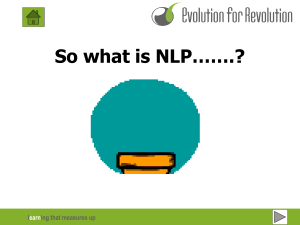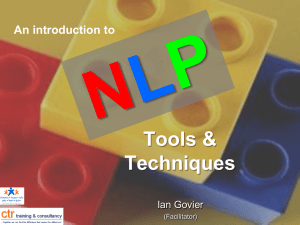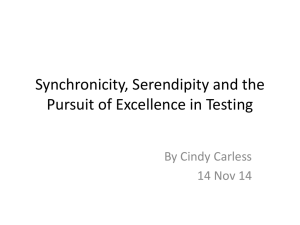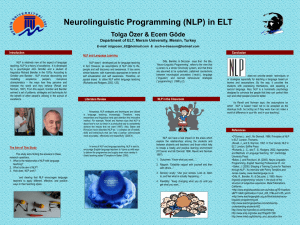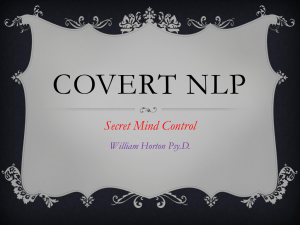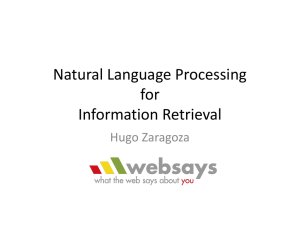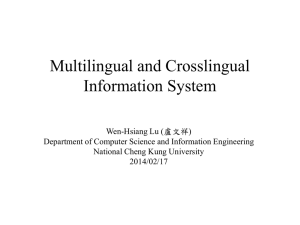entropy
advertisement
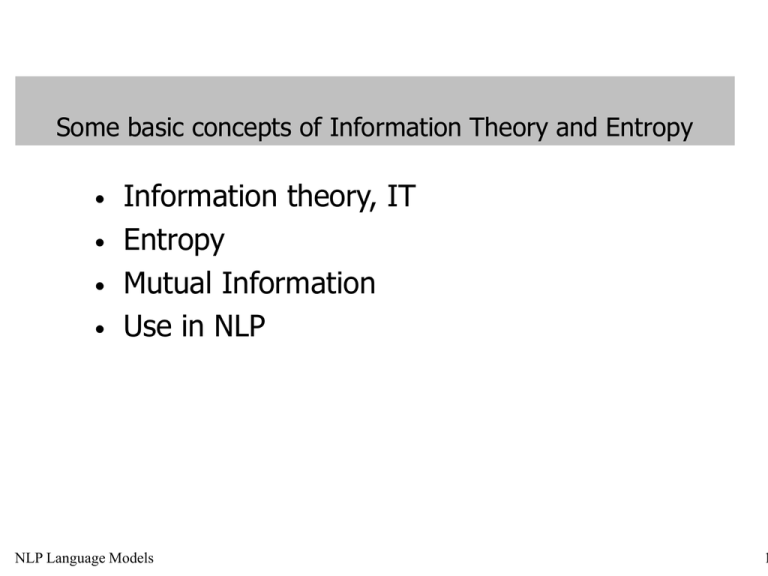
Some basic concepts of Information Theory and Entropy
•
•
•
•
Information theory, IT
Entropy
Mutual Information
Use in NLP
NLP Language Models
1
Entropy
•
Related to the coding theory- more
efficient code: fewer bits for more
frequent messages at the cost of
more bits for the less frequent
NLP Language Models
2
EXAMPLE: You have to send messages about the two
occupants in a house every five minutes
•
Equal probability:
0 no occupants
1 first occupant
2 second occupant
3 Both occupants
•
Different probability
Situation
no occupants
first occupant
Probability
Code
.5
0
.125
110
second occupant
.125
111
Both occupants
.25
10
NLP Language Models
3
•
•
•
Let X a random variable taking values x1, x2, ..., xn
from a domain de according to a probability
distribution
We can define the expected value of X, E(x) as
the summatory of the possible values weighted
with their probability
E(X) = p(x1)X(x1) + p(x2)X(x2) + ... p(xn)X(xn)
NLP Language Models
4
random variable W that can take one
Entropy
of several values
V(W) and a
probability distribution P.
•
Is there a lower bound on the number
of bits neede tod encode a message?
Yes, the entropy
•
It is possible to get close to the
minimum (lower bound)
It is also a measure of our uncertainty
about wht the message says (lot of
uncertain, few - certain)
NLP Language bitsModels
•
5
•
•
•
Given an event we want to associate its information
content (I)
From Shannon in the 1940s
Two constraints:
• Significance:
• The less probable is an event the more information it contains
P(x1) > P(x2) => I(x2) > I(x1)
• Additivity:
•
• If two events are independent
•
NLP Language Models
I(x1x2) = I(x1) + I(x2)
6
•
•
•
NLP Language Models
I(m) = 1/p(m) does not satisfy the
second requirement
I(x) = - log p(x) satisfies both
So we define I(X) = - log p(X)
7
•
•
•
•
Let X a random variable, described by p(X), owning an information
content I
Entropy: is the expected value of I: E(I)
Entropy measures information content of a random variable. We can
consider it as the average length of the message needed to transmite
a value of this variable using an optimal coding.
Entropy measures the degree of desorder (uncertainty) of the random
variable.
NLP Language Models
8
•
Uniform distribution of a variable X.
• Each possible value xi X with |X| = M has the same probability
pi = 1/M
• If the value xi is codified in binary we need log2 M bits of
information
•
Non uniform distribution.
•
•
•
•
by analogy
Each value xi has a different probability pi
Let assume pi to be independent
If Mpi = 1/ pi we will need log2 Mpi = log2 (1/ pi ) = - log2 pi bits of
information
NLP Language Models
9
Let X ={a, b, c, d} with pa = 1/2; pb = 1/4; pc = 1/8; pd = 1/8
entropy(X) = E(I)=
-1/2 log2 (1/2) -1/4 log2 (1/4) -1/8 log2 (1/8) -1/8 log2 (1/8) = 7/4
= 1.75 bits
X = a?
si
a
si
b
no
X = b?
no
X = c?
si
c
no
a
Average number of questions: 1.75
NLP Language Models
10
Let X with a binomial distribution
X = 0 with probability p
X = 1 with probability (1-p)
H(Xp)
H(X) = -p log2 (p) -(1-p) log2 (1-p)
p = 0 => 1 - p = 1 H(X) = 0
p = 1 => 1 - p = 0 H(X) = 0
p = 1/2 => 1 - p = 1/2 H(X) = 1
1
0
0
NLP Language Models
1/2
1
p
11
NLP Language Models
12
•
joint entropy of two random variables, X, Y is
average information content for specifying
both variables
NLP Language Models
13
•
The conditional entropy of a random variable Y
given another random variable X, describes what
amount of information is needed in average to
communicate when the reader already knows X
NLP Language Models
14
Chaining rule for probabilities
P(A,B) = P(A|B)P(B) = P(B|A)P(A)
P(A,B,C,D…) =
P(A)P(B|A)P(C|A,B)P(D|A,B,C..)
NLP Language Models
15
Chaining rule for entropies
NLP Language Models
16
Mutual Information
•
•
I(X,Y) is the mutual information between X
and Y.
I(X,Y) measures the reduction of
incertaincy of X when Y is known
It measures too the amouny of
information X owns about Y (or Y about X)
NLP Language Models
17
•
I = 0 only when X and Y are independent:
• H(X|Y)=H(X)
•
•
H(X)=H(X)-H(X|X)=I(X,X)
Entropy is the autoinformation (mutual
information between X and X)
NLP Language Models
18
NLP Language Models
19
Pointwise Mutual Information
•
The PMI of a pair of outcomes x and y belonging to
discrete random variables quantifies the discrepancy
between the probability of their coincidence given their
joint distribution versus the probability of their
coincidence given only their individual distributions and
assuming independence
•
The mutual information of X and Y is the expected
value of the Specific Mutual Information of all possible
outcomes.
NLP Language Models
20
•
•
•
•
H: entropy of a language L
We ignore p(X)
Let q(X) a LM
How good is q(X) as an estimation of
p(X) ?
NLP Language Models
21
Cross Entropy
Measures the “surprise” of a model q when it
describes events following a distribution p
NLP Language Models
22
Relative Entropy Relativa or Kullback-Leibler (KL) divergence
Measures the difference between two probabilistic distributions
NLP Language Models
23

